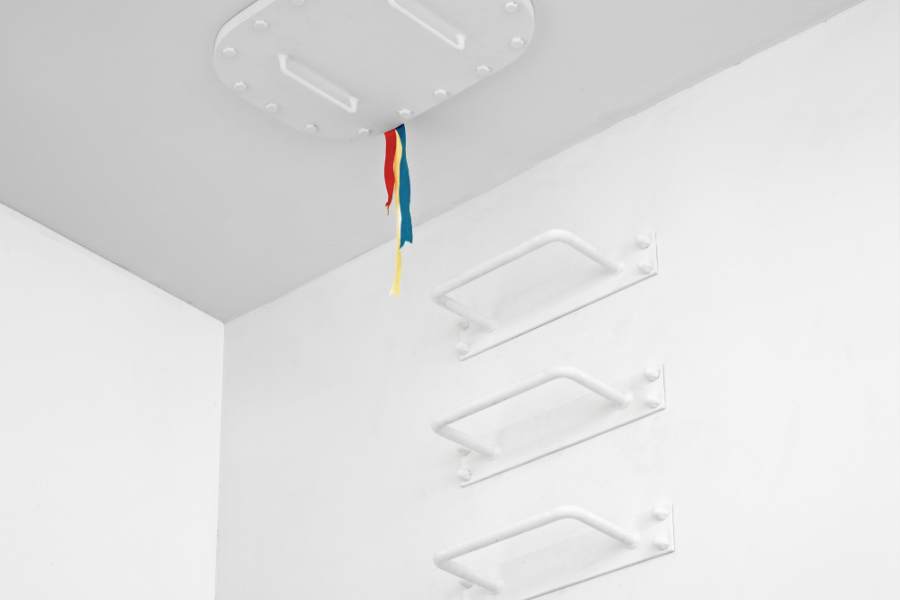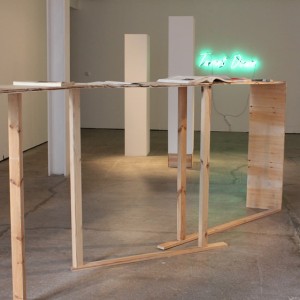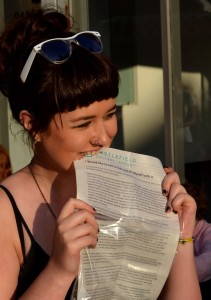The White Cube, The Artist And Me

Just who do artists make work for anyway? In an extension of his essay on visitor experience, Biennial 2014: The Space In Between, C James Fagan considers the impact of the white cube and whether it is dictating how art is made…
Lately, I’ve been questioning how we approach art; or rather, how artists expect us to approach art. Do artists think about how their work is seen and understood?
It may seem a ridiculous question to ask, but it is an important one. Do they think about the people looking at and interacting with their art, and is it a major factor in the making of the work? This line of thought was prompted by the Sharon Lockhart Biennial exhibition I recently wrote about; whatever you think about the actual content of her show, it’s clear that she considers the space the work inhabits and has thought about how people interact with it. Other exhibitions I’ve visited in the recent past have presented a conceptual framework so dense and complete, it removed the need for me, as the viewer, to actually be there.
It makes me wonder if artists do think beyond the academic or material nature of their art; how the work, or works, act when they’re set loose amongst the public.
One key example is Castlefield Gallery’s last group exhibition, I Would Like To Join A Club And Hit Myself With It; a collaboration with Manchester Art Gallery to coincide with their much publicised Ryan Gander touring exhibition, Make Every Show Like It’s Your Last. At Castlefield, artists were asked to respond to Culturefield, Gander’s ‘imagined place with the perfect conditions for creativity’. One piece, called Structure For Reading Whilst Standing, by designer and curator Robert Carter, took the form of a chipboard frame with books by Barthes, Virilio and placed on it.
Well it does what it sets out to do, doesn’t it? A structure for reading, with things to read. As a viewer, I’m unsure how to approach this; as a whole, or its individual conceptual and physical elements. How is this different to the spaces in other galleries given over to collections of relevant texts or reading materials? Is it meant to be different?

Ultimately, I didn’t know how to interact with, or ‘read’, the piece. The same extended to most of the works in the show — it was as if the combination of the artists’ contextualisation and its placement within the gallery rendered my presence unnecessary. I spent much of my time clutching the interpretation which was printed on rice paper (because art speak is hard to swallow?); not for the first time, I felt like I was wandering around an illustrated essay. The work existed in some academic, alternative universe.
I was aware that as part of this exhibition there was an audio piece available – Lois Macdonald, Audio Tour #1 : Join the Club – comprised of artists’ conversations during the install that visitors could listen to on headphones around the gallery; but as I came with someone this time, it seemed a little rude to listen to something else.
It also appeared to compound my doubts about the work being produced for the gallery space. That the gallery space becomes the ultimate destination: the completion of the piece, its only goal. It’s a difficult phenomenon to prove, but there is something in the fact that artists create content that becomes the context of the white walled space, which can lead, inadvertently perhaps, to an insular system.
Leaving visitors, like myself, outside of this system, unable to interact or to engage.
I’m pretty sure my interest in the way people experience art stems from studying a thing called ‘Spatial Design’, or Interior Architecture, at university. This involved spending a lot of time imagining how people would interact with the representations of spaces being sketched out on my drawing board.
How does this relate to art? Well, it occurs to me that the predominant form that art galleries have taken since the age of Modernism has been the White Cube. A space for art to exist in a space akin to a vacuum. The idea being that you, the viewer, will enter a meditative void where you can contemplate, absolutely and without distraction, the work before you.

Nothing wrong with that, but I have begun to wonder whether artists, subconsciously or not, have begun to create work which fits into this imagined void; making work which can be activated by being placed within this emptiness, in order to throw whatever concepts and meanings attached to these creations into sharp focus. Does this meditative, negative space actually exist? Do artists and viewers carry expectations regarding what galleries should be?
Thinking about my experience at Castlefield, I begin to consider my role as viewer, audience, and participant. How recently when I have enacted this role (visited a gallery) I have felt lost, staring at collections of objects which fail to coalesce into some kind of meaning?
It may appear that I’m picking on the artists at I Would Like To Join A Club And Hit Myself With It. It is simply the most recent example. I have seen exhibitions like this before: Father at Wolstenholme Creative Space, Liverpool; Glamourie at Project Space Leeds; the 2012 Liverpool Biennial.
At the danger of repeating this allegory (finding myself like Richard Dreyfuss in Close Encounters, pawing at his mash potatoes, mumbling ‘This means something…’), I can only imagine, in these given examples, that the artist is, simply, working in a vacuum to create work that exists in a vacuum… Forgetting that whatever work they create exists beyond its own boundaries, whether they be materialistic or conceptual. That the ultimate propose of art is to communicate a part of the human experience the artist has decided to throw their attention on.
I can’t definitely pronounce that the current system fails, but I do think that we should always consider how it works, and how to work with it. This was something Brian O’Doherty contemplated in his essay collection Inside The White Cube (1976). Nearly forty years ago, O’Doherty speculated on the affect the white cube gallery space would have on artists. For O’Doherty, the white cube isn’t as neutral as it appears — it comes loaded with history. It is the descendant of the church, the private room and showroom. This is even referenced in the interpretation to the aforementioned Castlefield Gallery exhibition, which states ‘how much the gallery space is always loaded with content’.
O’Doherty observed a paradox: although he identified that galleries come loaded with content, their apparent neutrally was an attempt to remove the gallery from this context; so on entering an exhibition, the visitor sees it as a single, self-contained and temporary entity.
I wonder if this combination of complex issues creates the conditions which support, feed or create the kind of work I’ve alluded to. Work that meets an expected conceptual criteria, a criteria that the artist and curator may not be necessarily aware of. The formation of a habit.
Here’s the thing: you could also argue, of course, that artists don’t actually have to consider the experience of this nebulous thing termed ‘the viewer’. At all. You could say it’s not their role nor should it be their main concern.
How art works, how it’s viewed, is a difficult notion to address. Some of the things I’ve written about can all be undone by the malleability of the gallery space and, of course, individual subjectivity. It doesn’t mean, however, that we shouldn’t look at the prescribed methods we have for the dissemination of art (that includes galleries and writing) and ensure they are working.
Otherwise, we run the risk of alienating art’s audience, closing off all lines of communication with those very people who keep our galleries open: you.
C James Fagan
Read Biennial 2014: The Space In Between





